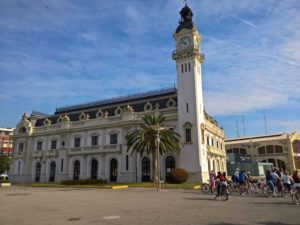
The PAV has put out to tender the project to improve the energy efficiency of the climate control plant of the Port of Valencia offices
Valenciaport will invest more than one million euros in the installation of elements which will achieve a reduction of 53,700 kg CO2/year
In recent years, the carbon footprint of the Port of València has been reduced by 30%
València, April 23rd, 2021.- The commitment of Valenciaport to the environmental sustainability of its installations and to become a port of reference in decarbonisation and environmental sustainability continues to advance in order to meet the 2030 objective, zero emissions. The Port Authority of Valencia (PAV) is going to invest more than one million euros in improving the energy efficiency of the air conditioning plant of the APV building in the Port of Valencia, which will allow a significant reduction in CO2 emissions from the facilities.
The action to be carried out consists of modifying the hydraulic system currently installed from fixed flow to variable flow to achieve significant savings in electrical energy. By replacing the current fixed-flow pumps with more efficient ones, the APV expects to achieve energy savings of 23%. At present, the consumption of the air conditioning plant in the port of Valencia is 650,000 kilowatts per hour per year, which is equivalent to 233,000 kilograms of carbon dioxide. Once this work – which has a completion period of five months – has been completed, Valenciaport expects a reduction of 53,700 kilograms of carbon dioxide per year.
The fight against climate change and the reduction of CO2 emissions and other polluting particles is an essential priority for the PAV. In this context, work is being done to make the reduction of the impact of port activities on the environment compatible with the growth of commercial activity. And this commitment is materialised with specific projects to achieve the Valenciaport 2030 objective, zero emissions, two decades ahead of the objectives that Spain, Europe and international organisations have projected for 2050.
In this regard, it should be noted that from 2008 to 2019 the carbon footprint of the Port of Valencia’s activity has been reduced by 30%, from 3.19 to 2.23 kg of CO2 per tonne handled. In the same period, the activity of Valenciaport grew by 42%, from 52 million tonnes handled in 2008 to 74 million tonnes at the close of the 2019 financial year.
Along these lines, Valenciaport is changing the lighting in the public roads of the ports of Sagunto and Valencia. Specifically, in the case of the Turia capital, 800 sodium vapour lights will be replaced, which will reduce energy consumption by 73% and avoid the emission of 269 tonnes of CO2 per year, while in Sagunto 500 lights will be replaced with a reduction in consumption of 54%.
Valenciaport’s Business Plan for the coming years includes actions to promote green energy and the reduction of energy expenditure within the framework of Valenciaport 2030, zero emissions. Thus, 3.2 million euros will be invested in energy efficiency programmes and consumption control systems, while 15 million euros will be invested in the generation of alternative energies for wind power generation and 2.8 million for photovoltaic generation systems.

